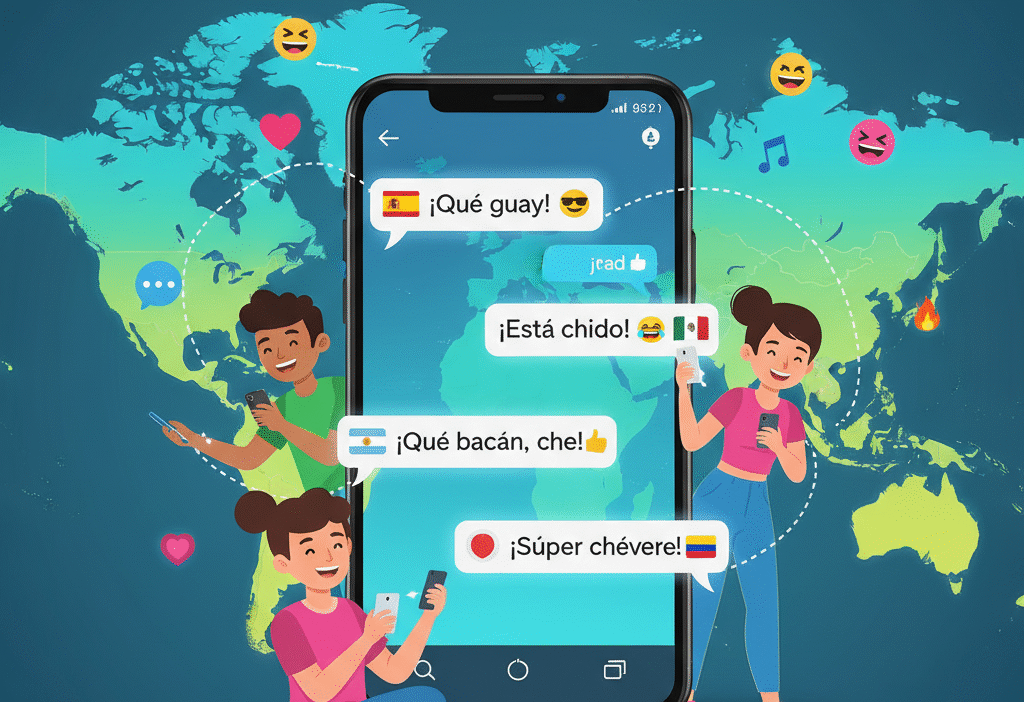How Do You Say “Cool” in Spanish Slang?
If you’ve ever texted a Spanish-speaking friend and wanted to say, “That’s cool,” you might be surprised — there’s no single translation.
Spanish slang is deeply regional. What’s “cool” in Mexico might sound strange in Spain, and what works in Chile could mean something else entirely in Argentina.
In English, “cool” expresses approval, admiration, or style. In Spanish slang, the word takes on hundreds of local personalities — from guay and chévere to padre, chido, bacán, and copado.
This guide breaks down how to say “cool” naturally in real-life Spanish, across countries and generations — not just textbook translations.
Quick Answer: The Most Common Ways to Say “Cool” in Spanish

| Country | Slang for “Cool” | Example Sentence |
|---|---|---|
| Spain | Guay | “Esa película está guay.” → That movie’s cool. |
| Mexico | Chido / Padre | “Tu camisa está chida.” → Your shirt’s cool. |
| Colombia | Bacano | “Qué bacano tu carro.” → Your car’s cool. |
| Venezuela | Chévere | “La fiesta estuvo chévere.” → The party was cool. |
| Argentina | Copado / Piola | “Qué copado sos.” → You’re cool. |
| Chile | Bacán | “Tu idea está bacán.” → Your idea’s cool. |
Why “Cool” Has So Many Spanish Versions
Unlike English, which exports slang globally, Spanish evolves region by region — each culture infuses its own style, humor, and tone into casual speech.
When you say “cool” in Spanish, you’re not just describing something stylish — you’re expressing identity.
For example:
- Guay sounds very European and laid-back.
- Chido and padre feel playful and Mexican.
- Chévere carries a Caribbean-friendly energy.
- Bacán and copado have Southern Cone authenticity.
That’s why understanding slang isn’t just translation — it’s cultural fluency.
Breaking Down the Most Popular “Cool” Slang by Region
1. Spain: “Guay”

- Meaning: Cool, great, awesome
- Usage: Very common among all age groups.
- Example: “Tu nuevo look está guay.” (Your new look is cool.)
- Tone: Friendly, informal, slightly retro but still popular.
- Synonyms: Genial, mola, or de puta madre (very slangy).
2. Mexico: “Chido” / “Padre”
- Meaning: Cool, awesome, nice
- Example: “Esa canción está bien chida.” (That song’s so cool.)
- Tone: Warm and playful. Padre literally means “father” but in slang = “awesome.”
- Variants: Padrísimo (super cool).
3. Colombia & Venezuela: “Bacano” / “Chévere”
- Meaning: Cool, great, fun
- Example: “Qué bacano verte.” (Cool to see you.)
- Tone: Universal compliment — can describe people, places, or events.
- Note: Chévere is also used in Puerto Rico, Peru, and Ecuador.
4. Argentina: “Copado” / “Piola”
- Meaning: Cool, chill, nice, kind
- Example: “Es un tipo copado.” (He’s a cool guy.)
- Tone: Chill, friendly, slightly hipster.
- Note: Piola can also mean “smart” or “clever.”
5. Chile: “Bacán”
- Meaning: Cool, awesome, stylish
- Example: “Ese diseño está bacán.” (That design’s cool.)
- Tone: Youthful, upbeat, often seen in memes and TikTok captions.
Contextual Uses: How “Cool” Varies by Situation
Depending on the tone, “cool” can mean:
- Approval: “Qué bacán tu idea.” (That’s cool!)
- Admiration: “Esa chica es copada.” (She’s cool/nice.)
- Sarcasm: “Ah, muy guay…” (Oh, cool… [ironic])
- Agreement: “Vale, guay.” (Okay, cool.)
Tone is key — especially in Latin slang, where intonation often changes meaning
Cultural and User Experience Context
When learning slang like “cool,” context is everything.
Each country’s version tells a story about its social attitude and lifestyle:
- Spain’s “guay” reflects a relaxed, easygoing vibe — like saying “chill” in English.
- Mexico’s “chido” represents creative youth culture and friendliness.
- “Bacán” in Chile mirrors urban street culture and digital expression.
- “Chévere” carries Caribbean warmth and rhythm.
Understanding which word to use where helps you sound native, not textbook.
💡 Pro tip: Try listening to regional podcasts or following influencers from different Spanish-speaking countries to hear slang in context.
How to Say “Cool” in Spanish Texting (2025)
Modern Spanish texting (especially on WhatsApp, Instagram, and TikTok) often shortens slang or combines it with emojis.
Examples:
- “Está guay 😎” — Spanish (Spain)
- “Bien chido 🔥” — Mexico
- “Bacán 😍” — Chile
- “Chévereee 😏” — Venezuela
- “Copado 👌” — Argentina
Slang in digital spaces is about tone and personality, not just words — emojis often reinforce meaning.

Advanced Tips: How to Use “Cool” Naturally in Spanish Conversations
- Mirror the culture:
Use chido with Mexicans, guay in Spain, chévere in Venezuela. Native speakers love when foreigners match their slang. - Be mindful of tone:
Guay or chévere = lighthearted.
De puta madre = very informal or vulgar — use with close friends only. - Don’t overtranslate “cool.”
Sometimes “cool” in English doesn’t need a direct word in Spanish — you can say genial (great), bueno (good), or just use an approving tone. - Watch age and setting:
Teen slang like bacán or padre might sound off if used in formal settings. - Absorb through content:
Listen to reggaetón lyrics, Spanish YouTubers, or Latin TikTok to pick up tone and rhythm — that’s where slang truly lives.
How “Cool” Translates Beyond Language — Cultural Symbolism
In Spanish slang, “cool” reflects not only admiration but also confidence, humor, and self-expression.
It’s part of a broader global trend: regional identity meets digital language.
While Americans might say “lit,” Spaniards say guay, Colombians say bacano, and Mexicans say chido.
Each word captures local values — from laid-back positivity to stylish flair.
This makes slang one of the most expressive ways to understand culture through language.
Slang Evolution: From 1990s to 2025
| Era | Expression | Common Use |
|---|---|---|
| 1990s | Guay, Chévere | Early internet chatrooms |
| 2000s | Chido, Padre | SMS and MSN Messenger slang |
| 2010s | Bacán, Copado | Meme culture, YouTube |
| 2020–2025 | Guay, Chévere, Chido (revived) | TikTok & Gen Z slang revival |
Slang often cycles back — guay and chévere are trending again among younger Spanish speakers online.
Common Mistakes When Using “Cool” in Spanish
- ❌ Using one slang everywhere — not all terms are universal.
- ❌ Translating literally (e.g., “frío” means cold, not cool).
- ❌ Forgetting tone — sarcasm and friendliness differ by culture.
- ✅ Correct: Adapting slang by country and formality.
FAQs: Cool in Spanish Slang
Q1. What’s the most common way to say “cool” in Spanish?
The word guay (Spain) or chévere (Latin America) are the most widely understood.
Q2. What’s “cool” in Mexican slang?
Use chido or padre. Example: “Esa fiesta estuvo chida.”
Q3. How do Argentinians say “cool”?
They often say copado or piola, depending on tone.
Q4. What does “chévere” mean?
It means “great” or “cool” — very common across Caribbean and South American countries.
Q5. Is it okay to use “cool” (English) in Spanish?
Yes! Many young speakers mix it with Spanish (“Está cool”), especially online.
Conclusion: Speaking “Cool” Like a Native
Saying “cool” in Spanish isn’t just vocabulary — it’s a way to connect.
Every term — from guay to chévere — reflects the culture and rhythm of the people using it.
When you choose the right slang, you’re not just translating — you’re communicating like a local.
So next time someone shows you a great song, outfit, or idea, skip the English cool” and say



